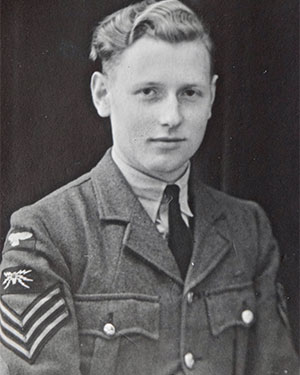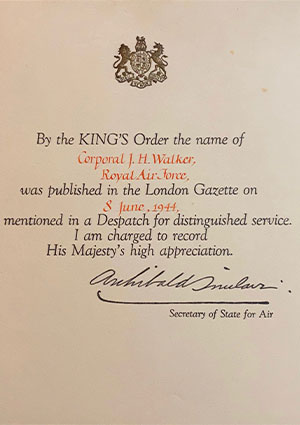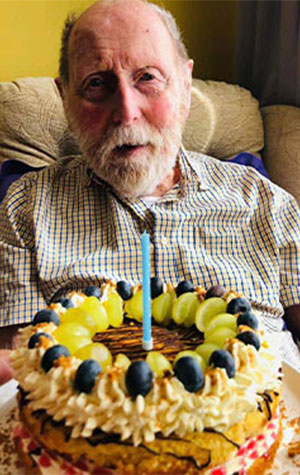When people move to a care home, they bring a lifetime of fascinating experiences and memoirs. Getting to know our residents helps staff build an understanding of their preferences and personalities and enables them to provide support in a thoughtful and meaningful way.
John Walker, now 97, lives at Ferrars Hall Care Home in Huntingdon. John joined the RAF in 1940 and has written extensive memoirs of his time both as an apprentice at RAF Cranwell and later postings at RAF Cranwell and RAF Wyton.
When I was due to leave school in the summer of 1939, I had no idea what to do next. Air Ministry Pamphlet No.15 “The Royal Air Force as a Career for Boys” was the answer! At RAF Halton, on March 5th 1940, aged 15, I took an oath to serve my country, its King and his successors until I reached the great age of thirty! With other would-be WEMs (Wireless and Electrical Mechanics) I was posted off to RAF Cranwell.
In the barrack rooms, our kit was on permanent display in the lockers over our bed heads ready for daily inspection, all folded to regulation and nothing of a personal nature, like family photos, was allowed to show. Discipline, PE, Drill and weapons training were in the hands of serving NCOs (non-commissioned officer).

We were taught Wireless Telegraphy, Morse code, by key and Aldiss lamp, Semaphore with flags, Technical and Workshops. Technical was the actual equipment we would work on. We took brief flights to practice using our Morse in flight in a Vickers Valencia twin-engine biplane or a, then modern, smaller de Haviland DH89 twin-engine biplane. This was a welcome escape from the classroom!
Off duty, time was spent in the Apprentices’ NAAFI playing billiards, snooker or darts, or just talking, drinking tea and eating a “wad” of which there was quite a variety. The large camp cinema had all the latest films and was run ably by a jovial older Warrant Officer known as Pop Billings.
Our pay to cover things like toothpaste, brass and boot polish was a shilling (5p) a day. We were paid 6 shillings of it every fortnight and the rest, less any charge for loss of kit or barrack damages when we went on leave.
1941 involved us as spectators in a moment of history. Rumours of experiments using jet propulsion had been circulating and on May 15th someone burst in to say there was “a kite on the South Drome without a prop (propeller)” We knew that one: it was having an engine change! But he was genuinely excited, so we went out to see and there was the first jet-propelled aircraft. It was a specially designed Fighter type of plane produced by Gloster, fitted with Frank Whittle’s jet engine. We were met by a ring of steel as guards levelled their bayonets at us in a very meaningful manner. We complained, but it was clear we were not getting any closer to this highly secret machine, but we were allowed to stay and watch.

After a while, Gloster’s chief test pilot came out, got in and for the first time we heard the sound of a jet engine. It was to become familiar later, but that day, exciting though it was, none of us realised just how momentous it was, too. We just watched our first jet take-off and went back to work. The test took place at 25000 feet so only those involved knew how it went until that special aircraft metamorphosed into the Gloster Meteor, the RAF’s first jet fighter.
In March 1942 came the finals and the tension of waiting for the results. I was relieved to find I was in Aircraftman First Class (AC1). Now came our postings and I was to go to RAF Wyton, I had no idea where that was!
When I arrived at Wyton, Pathfinders was being formed and I stayed in Pathfinders until almost the end of WW2. As soon as I was settled in, I was sent to share a 24 hour-on-24 hour-off shift routine with a corporal at Alconbury. As the USA had now come into the war after the disaster of Pearl Harbour, Alconbury was handed over to them and members of the USAAF started arriving. Those of us billeted there remained to represent the RAF until the handover was completed and we had two glorious weeks on American rations!
I was on call 24/7, checking equipment during the day and, on most nights, on the airfield from before the Halifaxes of 35 squadron took off on an op (a raid) until stand-down after the aircraft returned or hope was given up for those who didn’t. Of course, this meant I often had little or no sleep. But with no senior Signals rank to report to I was my own boss!
Pathfinders became independent and our section grew to include two Signals officers, a WO, a Sergeant Administrator, and I had a staff of 6 to do what I had done alone. But I did get a Mention in Despatches and I was promoted to Corporal.

Towards the end of the war, I was posted to the Group Transmitting station at Warboys to prepare for a new system than the existing Gee radar to enable pilots and navigators to know exactly where they were. However, it was now clear that large bombing raids were not going to be needed anymore and it was all cancelled. I then left Pathfinders and became involved in worldwide communication by automatic high-speed Morse and radio teleprinters. I taught at Leighton Buzzard and Cardington, then Watton in Norfolk.
My last posting was back to aircraft, in charge of the signals section of 224 squadron in Gibraltar. Flights over the Atlantic from Gibraltar to provide data to improve the accuracy of weather forecasting. We had a radar beacon on the Moroccan coast at Tangier on the south side of the Straits to guide incoming aircraft and avoid causing an international incident by straying into Spanish airspace. The beacon had to be checked weekly and we took it in turns to fly in a little de Haviland DH89 biplane for a pleasant day out to perform this simple duty.

After his RAF career John lived in Offord and then for over 50 years at Mill Common, Huntingdon until he moved to Ferrars Hall. He was a keen member of Huntingdon local history society and wrote a short history of Mill Common. He worked at the Acoustical Manufacturing Co in St Peters Road, Huntingdon from its inception rising to become General Manager during the company's heyday. They made ground-breaking Quad hi-fi equipment. He was closely involved with Trinity Church in Huntingdon and a lay preacher for many years.
For more information about life at Ferrars Hall Care Home in Huntingdon contact Customer Relations Manager, Maria Moore on 07979 635 744 or email maria.moore@countrycourtcare.com .